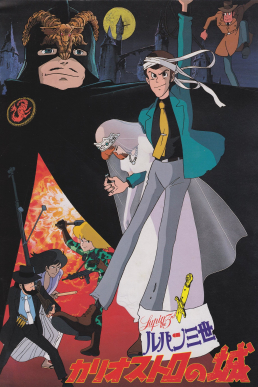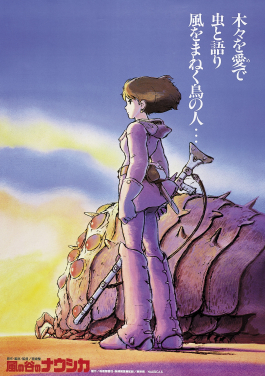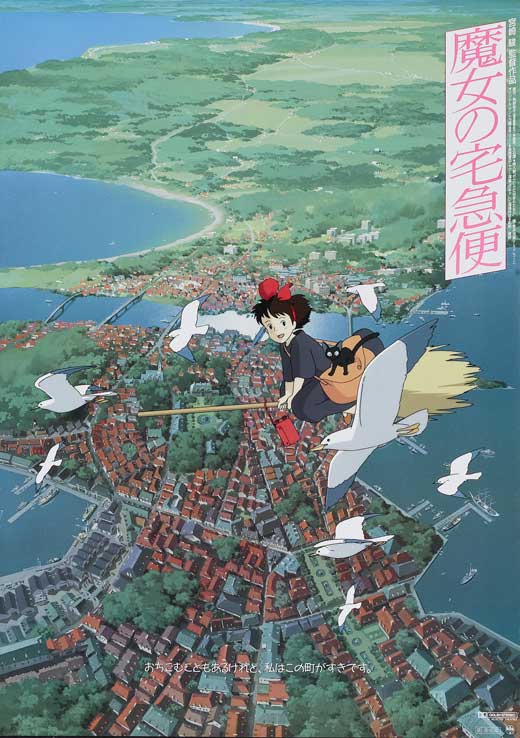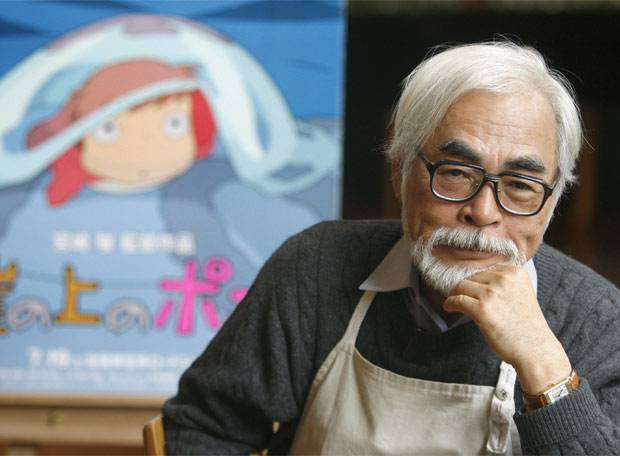As part of my personal anticipation for the upcoming North American release of Miyazaki's final film, The Wind Rises,
I thought that the best thing for me to do is review the previous ten
films that Miyazaki wrote and directed from 1979 to 2008. Of course, I
decided to do these reviews in two parts since there is an even amount
of films.
 |
| From my personal DVD collection |
So, I will start it out by reviewing his first five films: The Castle of Cagliostro, Nausicaä of the Valley of the Wind, Castle in the Sky, My Neighbor Totoro, and Kiki's Delivery Service.
The Castle of Cagliostro (1979)
Ah, yes. Miyazaki's first feature film, and it's the one I've seen the most out of all of his films. Also, this is indeed a Lupin the 3rd film. For a bit of history about this film, Miyazaki worked on the first two Lupin the 3rd television series for TMS Entertainment before he was given the chance to co-write and direct The Castle of Cagliostro. As much to the film's plot, there lies a pretty good story, and it's one that I enjoyed every time I watched it.
Lupin and his partner-in-crime, the gun-slinging Daisuke Jigen, heads to the Grand Duchy of Cagliostro after finding out that the money that they stole from a casino was counterfeit bills made with special plates that are only available there. As they go out to steal the plates, Lupin eventually saves a young runaway bride, who is suddenly revealed as Lady Clarisse, but she is chased again after Lupin becomes unconscious. After gaining consciousness, Lupin finds her ring, and suddenly recalls everything he knows about Cagliostro. They are soon joined by the samurai, Goemon Ishikawa XIII, who reveals that Inspector Zenigata (who aims to arrest Lupin throughout the series) is currently visiting with the film's main antagonist, Count Cagliostro (who plans on marrying Clarisse in part of revealing a secret treasure deep within the Grand Duchy and has another ring that is exactly like hers). Throughout the film, Lupin attempts to save Clarisse with some inside help from his former lover/arch-rival, Fujiko Mine (who is incognito as Clarisse's lady-in-waiting).
As I mentioned before, the story is actually really good, and it has some pretty intense and comical moments throughout the film. However, there is only one problem that mostly Lupin the 3rd fans tend to point out as they watch the film: Lupin is being portrayed more as a gentleman thief than his regular over-the-top self. Let me explain what I mean. Lupin was mostly created as a cocky womanizing thief who does get competitive with Fujiko Mine (who tends to tease him whenever she beats him to what he tries to steal). However, it seems like Miyazaki and his co-writer, Haruya Yamazaki, wrote him to be more like a gentleman than his regular self. Even though this does occur in the film that uses Lupin the 3rd characters, it's actually an accomplishment for Miyazaki.
Even though this is one of my personal favorite Miyazaki films, it's not my favorite Lupin the 3rd film (although I still do enjoy it as one).
Nausicaä of the Valley of the Wind (1984)
Miyazaki's second film is considered one of his best, and in my opinion, it is. Nausicaä of the Valley of the Wind was based off of his manga of the same name which was created so he would be able to make the film.
The film is based around Nausicaä, a peace-loving princess from the the Valley of the Wind, who tries to stop a nearby kingdom, the Tolmekians, from unleashing a secret weapon to eliminate the Ohm, which are giant mutant insects, that live in the Toxic Jungle. Throughout the film, she is also joined by Asbel, a young pilot from another kingdom, who aids her on her path to stop Kushana, the leader of the Tolmekains, from unleashing the Giant Warrior.
Some little trivia about this film, it was produced by Isao Takahata, who would eventually co-found Studio Ghibli with Miyazaki after the film was released, and the sequence with the Giant Warrior was animated by Hideaki Anno, who would eventually create the famous Neon Genesis Evangelion series. Also, when the film was first released in the U.S., it was heavily cut and renamed to "Warriors of the Wind" by New World Pictures. Their actions would later lead to the famous "No Cuts" rule for any foreign releases of any of the films by Studio Ghibli.
Castle in the Sky (1986)
In 1986, Miyazaki released the first Studio Ghibli film to audiences in Japan. Fully titled, Laputa: Castle in the Sky, the film is based on the story of Pazu, an orphan who lives in a small mining town, and Sheeta, the Princess of Laputa, who try to find the secret of a mystical stone amulet given to Sheeta with the help from a family of air-pirates before Colonel Muska and his army can.
I know I may be bashed about my opinion of this film, but I couldn't find myself to enjoy it as much as Nausicaä. Don't get me wrong. I love the animation, the characters, and the story. However, I felt that some of the film felt a bit similar to Cagliostro. I'm not saying that Miyazaki did a ripoff of one of his previous films, but it seems like he recycled the "secret" bit with this one. Also, I felt that the film had some scenes that weren't really necessary to the story.
Of course, without a doubt, it's still an enjoyable film.
My Neighbor Totoro (1988)
In 1988, Miyazaki released one of his first films that was aimed for a younger audience. Totoro is the story of Satsuki and Mei, who move to the country with their father so that they could be close to the hospital where their mother is being treated with tuberculosis, and how they met the local tree spirits simply known as Totoro.
The film itself is loosely based off of Miyazaki's personal life due to his mother was sick with tuberculosis when he was a child. Also, the film was originally rejected from being green lit until both Miyazaki and Takahata decided to create a double-bill featuring both Totoro and Takahata's Grave of the Fireflies, which was a film adaptation of Akiyuki Nosaka's semi-autobiographical novel of the same name. Originally, the double-bill wasn't financially successful, but the studio did gain profits after allowing a toy company to make dolls based around the Totoros in the film.
In my opinion, even as an adult, this is a rather enjoyable film. Mostly, the scenes with the Totoros and the Catbus (yes, there is a giant bus-like cat in the film) tend to be the really enjoyable parts of the movie.
Kiki's Delivery Service (1989)
A year after Totoro was released, Miyazaki released Studio Ghibli first financially successful film, and that film was none other than Kiki's Delivery Service.
Kiki is a coming-of-age story about a young witch-in-training who moves to another town with her cat, Jiji, so she could find a way to use her magical powers to indepently help others. She moves in with a couple who works as bakers, and she helps them deliver baked goods to the citizens of the town. Afterwards, she creates a delivery service, and befriends Tombo, a young man who is interested in aviation.
To be honest, this was the first Miyazaki film I heard about when I was a kid, but I didn't get to see it until I was in high school. Kiki was highly advertised on many of the Disney VHS releases during the late 90s, and the English dub had Kristen Dunst as Kiki, Matthew Lawrence as Tombo, and Phil Hartman (in one of his last film performances before his death in 1998) as Jiji.
That is five films down, and five more to go. Next time, I will be reviewing his other five available films.
Written by Nolan Schmidt



.jpg)
.jpg/220px-My_Neighbor_Totoro_-_Tonari_no_Totoro_(Movie_Poster).jpg)


No comments:
Post a Comment